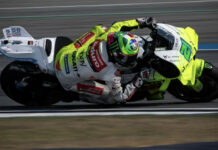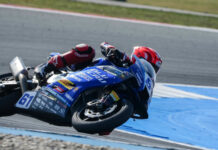Malaysian MotoGP™ debrief with Masao Azuma
Wednesday, October 29 2014
Bridgestone slick compounds available: Front: Medium & Hard. Rear: Soft, Medium & Hard (Asymmetric)
Bridgestone wet tyre compounds available: Hard (Main) & Soft (Alternative)
In sweltering conditions at Malaysia’s Sepang Circuit last Sunday, Repsol Honda’s Marc Marquez won his twelfth race of the 2014 season ahead of the determined Movistar Yamaha MotoGP duo of Valentino Rossi and Jorge Lorenzo who finished in second and third place respectively.
Extremely hot and humid temperatures over the race weekend created trying conditions for the riders, with Sunday’s race experiencing an ambient temperature of 35°C, while the track temperature reached 55°C. With the sun blazing overhead, Marquez was on a hot streak on track setting a new Sepang Circuit Best Lap record (1’59.791) in qualifying and a new Circuit Record Lap (2’01.150) during the race.
Q&A with Masao Azuma – Chief Engineer, Bridgestone Motorcycle Tyre Development Department
At the Malaysian Grand Prix Bridgestone provided a new hard compound front slick for the first time. What benefits does this new development offer compared to the previous hard compound front, and what did the riders have to say about it?
“There were certain characteristics about our old hard compound front slick that the riders liked, such as its stability under braking and its durability, but the general feedback was that it lacked a little in cornering performance. This meant that the target for this new tyre was to keep the good attributes of the old hard compound front slick and increase its cornering potential so we developed a new compound which the riders tested at the post-race test at Montmeló. The Catalan circuit also features high temperatures, long corners and hard braking zones so it was the perfect place to test this new development and the riders responded really well to it, so we decided to introduce it as soon as we could. The feedback we got from the riders last weekend was also positive and the new hard compound front slick was used by many riders throughout the weekend. Judging by the results of Sepang, this new development will definitely be a part of our tyre line-up in the future.”
Hot conditions at Sepang are nothing new, but this year was especially hot and humid. Did this cause any issues in regards to tyre performance or durability?
“This year was very hot at Sepang and in such conditions the track surface can become quite greasy which reduces grip levels. However, we were confident that our tyre allocation for this year’s Malaysian Grand Prix would provide very good performance no matter what the conditions. Lap times in the 1’59 bracket have been happening during winter testing at this circuit for a while now, but this year was the first time we saw those lap times during a Sepang race weekend, and in the end we had a new qualifying and race lap records despite track temperatures reaching almost 60°C. The scorching conditions caused no problems in terms of durability, with performance remaining consistent over race distance and tyre wear being well within the normal range.”
Even though conditions were very hot for the race, none of the Factory riders selected the hard compound rear slick for the race. Can you explain why all the Factory riders selected the medium rear slick?
“In the winter tests at Sepang earlier in the year, many riders were able to achieve good results using the hard compound rear slick, but the amount of grip available from the tarmac during the race weekend October is always less than in February, especially this year with its extreme heat. With less grip on offer from the tarmac, the riders need to compensate for this by selecting the rear tyre with the best level of grip, which for the Factory riders at Sepang was the medium rear slick. We still offered the hard compound rear slick this weekend as it has worked here very well in the past, but given the low grip on offer all the Factory riders felt they could achieve the best performance in the race using the medium compound rear. It was important for the teams and riders to know that the medium compound rear slick had the durability to provide consistent performance over race distance, and they were able to confirm this during the practice sessions.”






